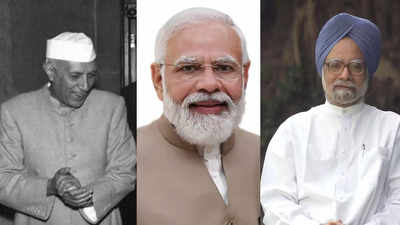- News
- India News
- List of all Prime Ministers of India: 1947 to 2024
Trending
List of all Prime Ministers of India: 1947 to 2024
An overview of India's Prime Ministers from 1947 to 2024, highlighting their roles, responsibilities, and key functions in the government structure as outlined in the Indian Constitution.

The Prime Minister of India is the chief executive of the Government of India and heads the Union Council of Ministers. While the President is the ceremonial head of state, executive authority is effectively vested in the Prime Minister and their Cabinet, who are accountable to the Lok Sabha, the lower house of Parliament. The Prime Minister is appointed by the President but must enjoy the confidence of the majority in the Lok Sabha.India has had 14 Prime Ministers since 1947, starting with Jawaharlal Nehru.
Notably, Indira Gandhi was the first female Prime Minister, and the Nehru-Gandhi family has held the position for approximately 38 years. Various political parties have held power, with leaders like Morarji Desai, Atal Bihari Vajpayee, and Manmohan Singh shaping India's political landscape. Narendra Modi, of the BJP, has served as Prime Minister since 2014, winning consecutive terms in 2019 and 2024, becoming the second after Nehru to do so.
Prime Ministers of India from 1947 to 2024
Notably, Indira Gandhi was the first female Prime Minister, and the Nehru-Gandhi family has held the position for approximately 38 years. Various political parties have held power, with leaders like Morarji Desai, Atal Bihari Vajpayee, and Manmohan Singh shaping India's political landscape. Narendra Modi, of the BJP, has served as Prime Minister since 2014, winning consecutive terms in 2019 and 2024, becoming the second after Nehru to do so.
Prime Ministers of India from 1947 to 2024
All Prime Ministers of India: Important points
- Appointment and role: According to Article 75 of the Indian Constitution, the Prime Minister is appointed by the President of India. The Prime Minister leads the Cabinet and holds the main executive powers, while the President serves as the nominal head of state.
- Duties and responsibilities: Article 78 outlines the duties of the Prime Minister. The PM acts as a crucial link between the President and the Cabinet, ensuring the smooth functioning of the government.
- Parliamentary functions: The Prime Minister plays a pivotal role in Parliament. They determine the schedule for Parliament sessions, including prorogation and dissolution of the House. As the chief spokesperson, they announce government policies and answer questions from members.
- Executive authority: The PM wields significant executive authority. They recommend appointments to the President, allocate and reshuffle ministerial portfolios, and preside over meetings of the Council of Ministers, influencing their decisions.
- Dismissal authority: The Prime Minister has the authority to request resignations from ministers or recommend their removal to the President, ensuring accountability within the government structure.
Also Read | List of Presidents of India from 1950 to 2024
End of Article
FOLLOW US ON SOCIAL MEDIA











